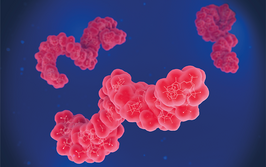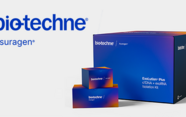Salivary Secrets
Levels of five microRNAs in saliva can hold clues to the length of time concussion symptoms may last
Concussion: an unpleasant diagnosis at best, dangerous at worst – and even more worrying if it’s not your diagnosis, but your child’s. But concussions vary – sometimes symptoms are mild and fade within a week or so, but they can also linger, causing prolonged difficulty and discomfort. How do we know which is more likely? At the moment, we use a survey of experienced symptoms – but researchers from Penn State College of Medicine believe the levels of five microRNAs (miR-320c-1, miR-133a-5p, miR-769-5p, let-7a-3p, and miR-1307-3p) in saliva may offer a more accurate prediction (1). We spoke to principal investigator Steven Hicks to learn more about the discovery.

What inspired you to investigate prolonged concussion in children?
I was inspired by my experience as a general pediatrician; I often see and treat children with concussions. Currently, there are no objective tools to predict how long a concussion might last. Most are better in two weeks, but up to 33 percent may persist beyond this period, which is frustrating for both parents and doctors. It makes it very difficult to develop accurate prognoses and individualized treatment plans.
Unlike protein biomarkers, which have difficulty crossing the blood-brain barrier, microRNAs are used by the brain as small signaling molecules and can easily cross into other body fluid compartments – and they are extremely concentrated in saliva. Because our previous work had shown that microRNAs are related to other disorders of the brain, including autism, we decided to explore whether they might help us identify and characterize concussions.
Can you describe the microRNAs you identified?
The microRNAs we identified target gene pathways that are highly related to brain processes. They control axon outgrowth and plasticity – processes that would be extremely important in responding to a brain injury. So unlike protein biomarkers, which generally increase to indicate that a major cellular injury has occurred, microRNAs may actually decrease to allow a protective or adaptive cellular response to neuronal injury. Failure to initiate these molecular pathways (because of underlying genetic reasons or through triage of more immediately important cellular injury or death pathways) might predispose some children to prolonged concussion symptoms.
We also looked at relationships between individual microRNAs and the severity of specific symptoms, such as headache, fatigue, or attention difficulty one month after concussion – and we found several strong correlations. In this manner, levels of specific microRNAs in the first week after an injury might allow us to accurately predict how long symptoms might last, what character those symptoms might take on, and how severe they might be.
How could this translate to a clinical test?
If successful, this approach would give medical professionals an objective way of determining whether a concussion has occurred, how long it might last, and what symptoms might be most problematic. In its current form, this would be an in-office salivary swab processed by a lab within 24 hours – but with advancing technology, point-of-care testing is not far away. This type of knowledge could also help advance research – for instance, by carefully selecting participants for clinical trials to assess the treatment efficacy of certain medications, rather than enrolling any patient with concussion.
Before such a test can enter the clinic, though, it will need to be validated in a larger prospective cohort across a broader age range. The company sponsoring this research has laid a foundation for quick and accurate sample processing and secure return of results. They hope to bring the test to market in one to two years. We are always looking for researchers who are interested in collaborating and I think this type of open, collegial approach will speed the development of the technology.
What are you working on now?
We have some very exciting results, soon to be published, examining the diagnostic potential of salivary RNA profiles in children with autism – a study that currently has over 400 participants and equally promising findings.
In the concussion realm, we are moving forward to validate our work. We are using a longitudinal sample collection design and pairing microRNA profiles with functional measures of concussion symptoms (balance and cognition) as well as subjective symptom reports.
- JJ Johnson et al., “Association of salivary microRNA changes with prolonged concussion symptoms”, JAMA Pediatr, [Epub ahead of print] (2017). PMID: 29159407.

While obtaining degrees in biology from the University of Alberta and biochemistry from Penn State College of Medicine, I worked as a freelance science and medical writer. I was able to hone my skills in research, presentation and scientific writing by assembling grants and journal articles, speaking at international conferences, and consulting on topics ranging from medical education to comic book science. As much as I’ve enjoyed designing new bacteria and plausible superheroes, though, I’m more pleased than ever to be at Texere, using my writing and editing skills to create great content for a professional audience.




















